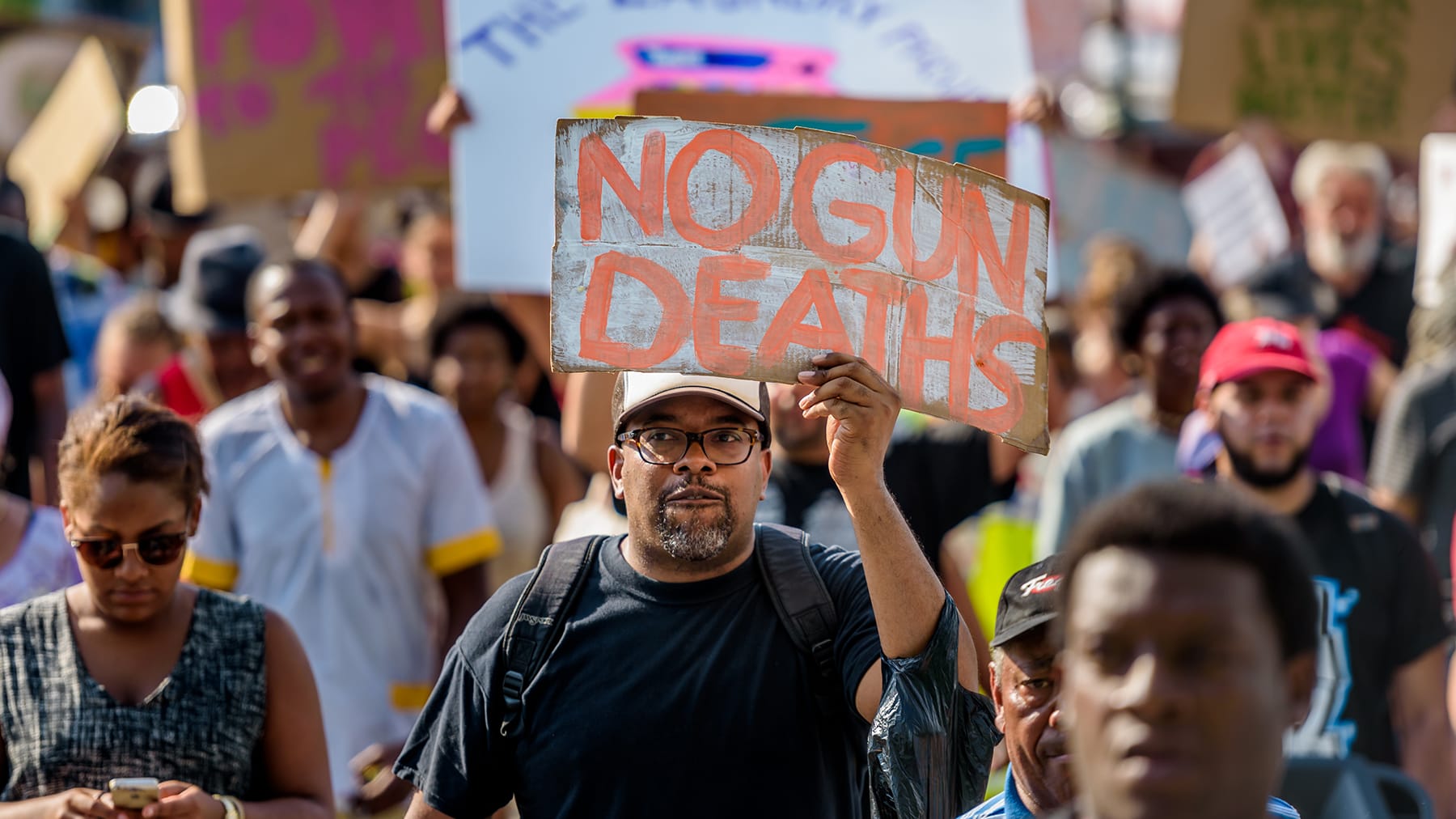
Bolstering Police-Community Relations in the Trump Era
This week, Giffords Law Center released a new report, In Pursuit of Peace: Building Police-Community Trust to Break the Cycle of Violence , which explores the downward cycle of violence that results from a breakdown in trust between communities and law enforcement.
Below we break down a few key themes of the report, and highlight opportunities for improving police-community relations in the Trump era.
Police Violence is Gun Violence
Police-involved shootings take the lives of an estimated 1,000 people every year. Though police-involved shootings make up a small share of all gun deaths overall, and may be legally justified in response to to legitimate threats, these tragedies can have a significant deleterious impact on public safety, often exacerbating distrust of law enforcement in communities of color that have been both over-policed and under-protected for generations.

Trust and Legitimacy Are Essential to Just and Effective Policing
To solve crimes, police count on members of the community to report unlawful activity, share information with investigators, and come forward and testify in open court as witnesses. But when law enforcement is perceived as unjust, ineffective, or illegitimate, they are unlikely to receive this type of active public participation.
In 2016, a team of researchers demonstrated that after on- and off-duty officers attacked Milwaukee resident Frank Jude in October 2004, city residents became significantly less likely to call 911 for over a year. The police department saw a significant drop in 911 calls reporting violent crimes after the incident was publicized, especially from predominantly minority neighborhoods; receiving an estimated 22,000 fewer 911 calls after the incident despite a concurrent 30% increase in the number of homicides citywide.
Without active participation from the public, law enforcement finds it much more difficult to hold perpetrators of violence accountable, which leaves many violent crimes unsolved, particularly those committed against people of color. In 2016, homicide claimed the lives of more black men aged 15–24 than all other causes of death combined —yet less than half of all murders involving black victims led to an arrest, let alone a conviction.
Instead, traditional policing practices and the justice system have too often focused on incarcerating Americans—especially people of color—for lesser, nonviolent offenses like drug and property crime. In fact, police in the US arrest more people for possession of small quantities of marijuana than for all violent crimes combined.
Ultimately, over-enforcement of minor offenses, combined with a failure to address residents’ most pressing concerns—shootings and homicides—fuels the perception that law enforcement can’t or won’t keep impacted communities safe. In the absence of a trusted police force, a handful of residents turn to vigilante or street justice instead, joining groups that engage in deadly cycles of retaliatory violence. Consequently, research indicates that homicide rates tend to be highest in areas where law enforcement is seen as illegitimate.
Some Police Departments Are Recognizing the Need to Build Police-Community Trust
Dozens of cities across the country are beginning to understand the benefits of strong police-community relations and have taken up efforts to reform policy, reset priorities, and institute department-wide structural change.
In Camden, New Jersey, for example, after budget cuts forced the city to lay off half of its police force, the department was reconstituted as a new county police force with community policing and trust-building at its core. Officers made concerted efforts to cultivate positive interactions with residents, engaged in de-escalation training, and created new use-of-force policy, among a number of other reforms. Since 2012, Camden has cut its annual homicides by two-thirds.

To replicate the progress of communities like Camden, Minneapolis, and Stockton, city leaders and law enforcement should work to implement the recommendations of the 2015 national blue ribbon Task Force on 21st Century Policing, and refocus law enforcement resources to prioritize the prevention of serious violence and protection of human life. Congress and state legislatures should also invest in intervention programs that help to break the cycle of violence and build trust between community members and law enforcement, starting with passage of federal legislation like the Break the Cycle of Violence Act and reauthorization of the National Initiative to Build Community Trust and Justice.
Despite promising early results, the Justice Department did not renew federal funding for the National Initiative, one of many disappointing actions taken by the current administration to tie the hands of local law enforcement seeking to develop a better relationship with the communities they serve.
The Trump Administration is Making it Harder for Local Police Departments to Implement and Evaluate Reform
Aside from discontinuing funding for the National Initiative, the president and current Justice Department have repeatedly blocked or aimed to eliminate a number of federal resources for local law enforcement agencies seeking to develop stronger police-community relations.
The current administration’s Justice Department has all but eliminated the use of settlement agreements and consent decrees as a tool for federal oversight of law enforcement, and has all-but ended the Civil Rights Division’s Collaborative Reform Initiative, which was intended to provide comprehensive assessments and reform recommendations to police departments that requested them. The initiative no longer provides assessments, and in fact, the DOJ has refused to share completed assessments with departments, even after multiple inquiries from various agencies and elected officials.
In October 2019, President Trump signed an executive order establishing a national Commission on Law Enforcement and the Administration of Justice to study and make recommendations on issues related to law enforcement and the administration of justice.
It has never been more important to make the case, loudly and persuasively, that trust and legitimacy in policing is a gun violence prevention issue. In order to more justly and effectively protect and serve communities devastated by violence, trauma, and fear, our law enforcement agencies must engage community partners and transparently redress policing models that have harmed so many Americans.